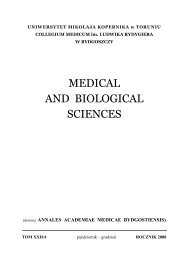Medical and Biological Sciences XXVI/2 - Collegium Medicum ...
Medical and Biological Sciences XXVI/2 - Collegium Medicum ...
Medical and Biological Sciences XXVI/2 - Collegium Medicum ...
Create successful ePaper yourself
Turn your PDF publications into a flip-book with our unique Google optimized e-Paper software.
20<br />
Magdalena Hagner-Derengowska et. al.<br />
w stabilnych warunkach. W niniejszej pracy podjęto próbę<br />
oceny zmienności przestrzennych i czasowych parametrów<br />
chodu.<br />
Materiał i m e t o d y . W pracy wykorzystano 29<br />
losowo wybranych zapisów chodu na bieżni. Każdy zapis<br />
analizowano trzy razy w różnych punktach czasowych –<br />
zaczynając od 5., 25. i 45. sekundy chodu. Każda analiza<br />
obejmowała 10 kroków i była wykonywana przez tę samą<br />
osobę. Przestrzenne i czasowe parametry z otrzymanych<br />
analiz dla każdego zapisu zostały porównane przy użyciu<br />
st<strong>and</strong>ardowych narzędzi statystycznych. Cały pomiar i zapis<br />
zostały wykonane przy użyciu opartego na ultradźwiękach<br />
systemu do przestrzennej analizy ruchu – ZEBRIS, z jednostką<br />
główną CMS-HS, oprogramowaniem WinGait i protokołem<br />
pomiarowym „15 markers”.<br />
W y n i k i . Uzyskane wyniki wskazują bardzo wysoka<br />
(prawie idealną) korelację (od 0,92 do 1, średnia 0,97 i od 0,94<br />
do 1, średnia 0,98) odpowiednio dla czasowych i przestrzennnch<br />
parametrów pomiędzy wszystkimi analizami.<br />
Średnia różnica w parametrach przestrzennych wynosi 0,7<br />
stopnia, przy maksymalnej różnicy dla jednego ruchu równej<br />
1,3 stopnia. Średnia różnica w wartości procentowej faz<br />
podporu i przenoszenia wynosi 0,8%, a średnia różnica w<br />
długości kroku wynosi 10,5 mm.<br />
W n i o s k i . Bardzo wysoka korelacja między<br />
uzyskanymi wynikami i niewielkie różnice w parametrach<br />
przestrzennych i czasowych pokazują, że analiza chodu za<br />
pomocą systemu opartego na ultradźwiękach może być<br />
uzywana do celów tak klinicznych, jak i badawczych.<br />
Pokazuje również, że analiza na części otrzymanego zapisu w<br />
dowolnym miejscu na osi czasu jest reprezentatywna dla<br />
całego pomiaru.<br />
Key words: gait, 3D movement analysis, gait parameters<br />
Słowa kluczowe: chód, trójwymiarowa analiza ruchu, parametry chodu<br />
INTRODUCTION<br />
Gait is one of the most often analysed forms of<br />
movement not only when it comes to supporting a<br />
diagnosis or controlling treatment, but also as far as<br />
evaluating the progress of a disease at a clinic or in<br />
research is concerned. There are many ways of<br />
assessing the above. They include simple<br />
questionnaires <strong>and</strong> visual control, as well as<br />
sophisticated, high technology equipment. The latter<br />
comprise mainly high speed cameras <strong>and</strong> infrared<br />
radiation or ultrasound microphones <strong>and</strong> transmitters.<br />
Regardless of methodology used, assessing the<br />
changeability of gait parameters in order to decide<br />
whether changes observed with respect to various<br />
measurements or gait disturbances could be considered<br />
as significant or not of great importance. This<br />
changeability is not only characteristic for a given<br />
parameter, but also depends on the measuring system<br />
<strong>and</strong> the number of gait cycles that are used for an<br />
analysis. Methodology itself matters as well.<br />
In this paper the authors try to assess the usefulness<br />
of a 3D ultrasound-based motion analysis system<br />
manufactured by ZEBRIS GmbH, Germany, <strong>and</strong> of<br />
methods concerning data analysis based on 10 cycles<br />
of gait.<br />
MATERIALS AND METHODS:<br />
Materials<br />
The study was carried out with the use of 29<br />
records of gait measurements taken in a group<br />
consisting of women aged 22-66 (x=45.4, S.D. 15.6).<br />
All measurements were taken within a st<strong>and</strong>ard<br />
diagnosis procedure in the ‘Pod Tężniami’ Health<br />
Clinic in Ciechocinek from March to September 2009.<br />
The research included records of at least 70-second<br />
recordings that showed no visible technical<br />
disturbances or no serious gait disorders. The<br />
recordings used during the research were chosen from<br />
a number of measurements taken from January to July<br />
2009.<br />
Methods<br />
All measurements of gait were taken with the use<br />
of a 3D ultrasound-based motion analysis system,<br />
ZEBRIS, equipped with a main unit – CMS HS – <strong>and</strong><br />
two measuring units (one for each side of the body), as<br />
well as WinGait software designed for gait analysis.<br />
During the test, patients were walking on a st<strong>and</strong>ard<br />
Kettler treadmill, the inclination of which was 1 degree<br />
(a minimum for this type of treadmill). The speed was<br />
constant <strong>and</strong> set to a value that suited each participant.<br />
All recordings were taken with the use of a ‘15<br />
markers’ measuring protocol which assesses pelvic,<br />
hip, knee <strong>and</strong> foot movement. Before a recording took<br />
place a patient had been walking on a treadmill, the<br />
speed of which was selected beforeh<strong>and</strong>, for 3 minutes<br />
<strong>and</strong> stated that he/she felt comfortable <strong>and</strong> was walking<br />
in a natural manner. Every record was analysed three<br />
times. The method used for data processing was fully<br />
manual (3 markers) <strong>and</strong> produced three st<strong>and</strong>ard<br />
reports, each based on 10 steps, starting at different<br />
time points, i.e. 5 th , 25 th <strong>and</strong> 45 th second of recording

















